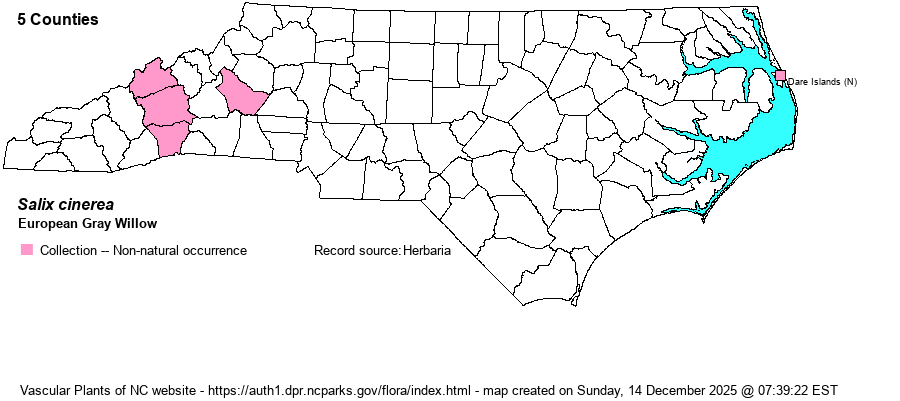| Author | L. | |
| Distribution | Mostly in the Mountains; disjunct to Roanoke Island in Dare County. We only include specimens annotated by G. Argus; some of them were originally determined as S. caprea.
Native of Eurasia; in N.A. MA to Ont. and IA, south to GA and LA; also SD, UT. | |
| Abundance | Very rare, though as with S. caprea, this species can grow in bogs and has impacted the rare natural community and rare plants in such sensitive sites. | |
| Habitat | Streambanks, seepy roadbanks, montane bogs, wet margin of brackish marsh. | |
| Phenology | Flowering April-May. | |
| Identification | The group of S. cinerea-atrocinerea-caprea are not always clean-cut to ID to species. See FNA (2010) and Weakley (2018) for keys and discussion. | |
| Taxonomic Comments | The genus Salix is a very large and complex group of plants that vary from ground-hugging Arctic belly plants to huge trees. There are 113 species in North America alone, including introduced species. They are extremely important to browsing mammals -- rabbits, deer, elk, muskox, moose, many rodents -- and browsing birds like ptarmigan. Many birds use them to nest in. Here in NC we only have a small number of native species (5) and so do not appreciate the ecological importance of willows. We highly recommend reading the introductory pages of George Argus's FNA treatment (2010) and his excellent monograph on the willows of the southeastern U.S. (1986). The latter has drawings and descriptions of all southeastern U.S. taxa. Due to natural and horticultural hybridization, some plants will not key cleanly and you may have to compare your specimen with others verified by Argus. | |
| Other Common Name(s) | | |
| State Rank | SE | |
| Global Rank | G5 | |
| State Status | | |
| US Status | | |
| USACE-agcp | FACW link |
| USACE-emp | FACW link |

